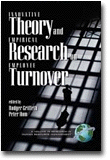
Innovative Theory and Empirical Research on Employee Turnover
Edited by:
Rodger Griffeth, Ohio University
Peter Hom, Arizona State University
A volume in the series: Research in Human Resource Management. Editor(s): Dianna L. Stone, Universities of New Mexico, Albany, and Virginia Tech. James H. Dulebohn, Michigan State University. Brian Murray, University of Dallas. Kimberly M. Lukaszewski, Wright State University.
Published 2002
This book includes contributions from a variety of different perspectives on employee turnover. We categorize these myriad papers in terms of history, scope, theory development, and population generalization. Part I thus begins with an article by James Price, a pioneering thinker in the turnover field. Initiating the most systematic turnover research ever undertaken, Dr. Price describes his persistent quest to develop and refine a comprehensive theory of turnover. His 30-year intellectual journey offers valuable insight into theoretical and methodological challenges that continue to confront all turnover researchers.
CONTENTS
Foreword, Rodger Griffeth and Peter Hom. PART I: THE EVOLUTION OF A PIONEERING TURNOVER THEORY. The Development of a Causal Model of Voluntary Turnover, James L. Price. PART II: IDENTIFYING
CONSTRUCTS AND PROCESSES MISSING FROM PREVAILING TURNOVER FORMULATIONS. Explaining the Link between Turnover Intentions and Turnover: The Roles of Risk, Personality and Intentions-behavior Linkages, David G. Allen. Revisiting the Cosmopolitan–Local Construct: An Event History Analysis of Employee Turnover, Roderick D. Iverson, Charles W. Mueller and James L. Price. Job Markets and Turnover Decisions, Robert P. Steel. Stress Measures as Predictors of Intention to Leave and Turnover, Meni Koslowsky and Meyrav Merom. PART III: INNOVATIVE NEW WAYS OF THINKING ABOUT
TURNOVER. Five Antecedents Neglected in Employee Turnover Models: Identifying Theoretical Linkages to Turnover for Personality, Culture, Organizational Performance, Occupational Attachment, and Location Attachment, Carl P. Maertz, Jr. Job Embeddedness: Current Research and Future Directions, Xin Yao, Thomas W. Lee, Terence R. Mitchell, James P. Burton and Chris J. Sablynski. Dynamic Systems in Human Resource Management: Chaos Theory and Employee Turnover, Reidar Hagtvedt, Gregory Todd Jones, Stefan Gaertner and Rodger Griffeth. PART IV: GENERALIZING TURNOVER THEORY AND RESEARCH TO NEGLECTED POPULATIONS. On the Relationship Between Race and Turnover, Loriann Roberson. Investigating Turnover in the International Context: A Turnover Model for the Mexican Culture, Mindy S. West.
MORE INFORMATION
Read a sample chapter from this book
-
Paperback978-1-59311-096-3
Web price: $45.04 (Reg. 52.99)
-
Hardcover978-1-59311-097-0
Web price: $80.74 (Reg. 94.99)
- eBook9781607524953

-
 Diversity and Inclusion in Organizations
Diversity and Inclusion in Organizations
-
 Forgotten Minorities in Organizations
Forgotten Minorities in Organizations
-
 Leadership
Leaders, Followers, and Context
Leadership
Leaders, Followers, and Context
-
 Managing Team Centricity in Modern Organizations
Managing Team Centricity in Modern Organizations
-
 Research Methods in Human Resource Management
Toward Valid Research-Based Inferences
Research Methods in Human Resource Management
Toward Valid Research-Based Inferences
-
 The Only Constant in HRM Today is Change
The Only Constant in HRM Today is Change
-
 The Plight of Stigmatized Groups in Organizations
The Plight of Stigmatized Groups in Organizations

